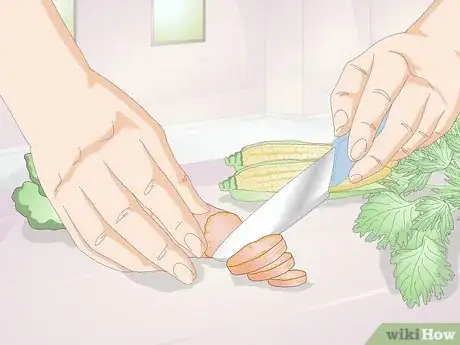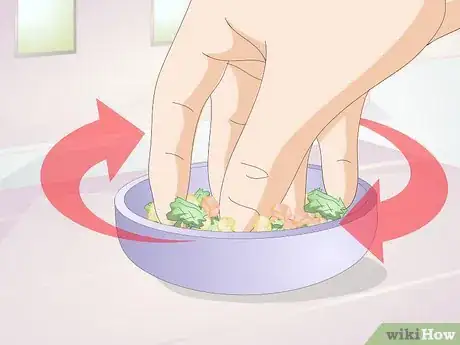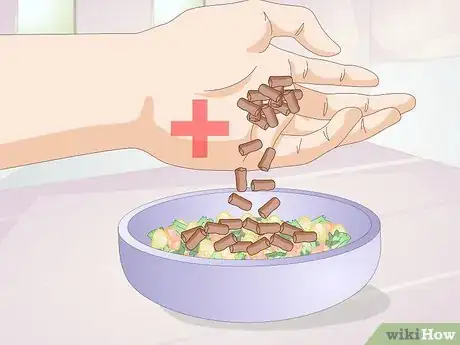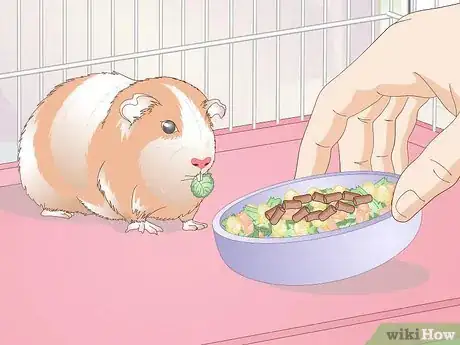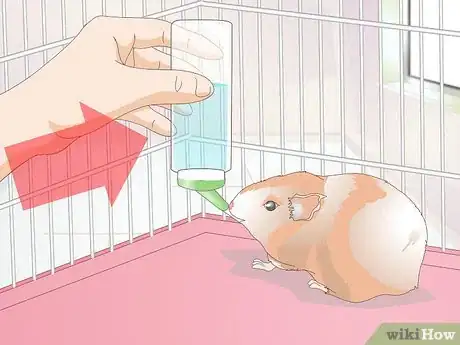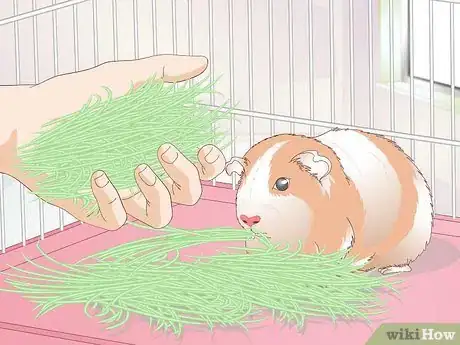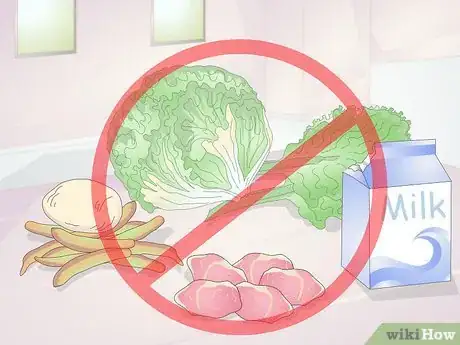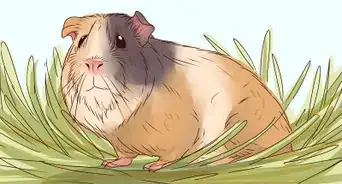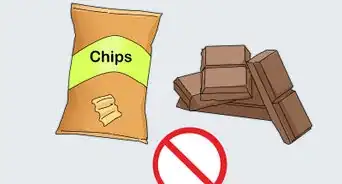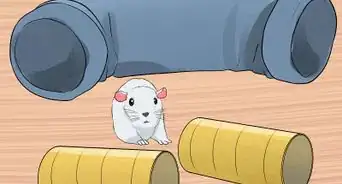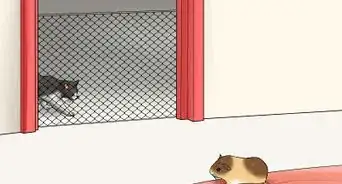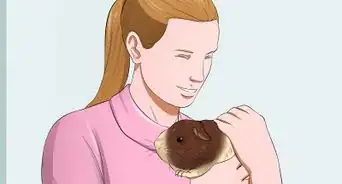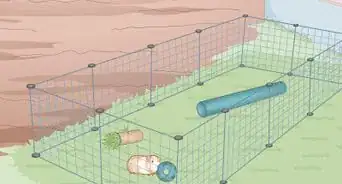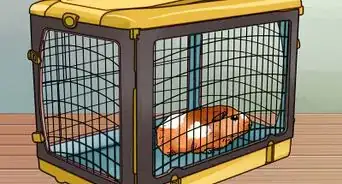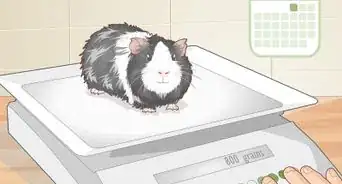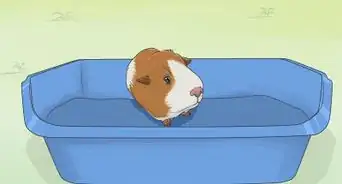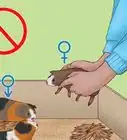This article was co-authored by Pippa Elliott, MRCVS. Dr. Elliott, BVMS, MRCVS is a veterinarian with over 30 years of experience in veterinary surgery and companion animal practice. She graduated from the University of Glasgow in 1987 with a degree in veterinary medicine and surgery. She has worked at the same animal clinic in her hometown for over 20 years.
wikiHow marks an article as reader-approved once it receives enough positive feedback. In this case, 82% of readers who voted found the article helpful, earning it our reader-approved status.
This article has been viewed 107,581 times.
Guinea pigs are excellent pets, but their dietary needs may be somewhat confusing. It is especially important to understand them if you want to try to make your pet's food instead of giving it store-bought food. Fortunately, there are a wide variety of vegetables and other foods guinea pigs can eat. With a little work and some knowledge, you'll be able to make your guinea pig food in no time.
Steps
Preparing to Make Your Guinea Pig Food
-
1Consult your vet. Before you do anything, you should talk to your vet about the individual needs of your guinea pig. This way, you’ll have all of the information you need to make sure your guinea pig will stay happy and healthy before you embark on the journey of making your guinea pig food. Consider:
- Your guinea pig might have specific nutritional needs due to pre-existing conditions.
- Your vet might be able to provide you with a detailed list of vegetables and/or pellets to include in your mix.
- Your guinea pig might have specific nutritional needs due to age, size, or breed.[1]
-
2Buy diverse vegetables. Your guinea pig should have several vegetables in his or her food. This is important because different foods provide different vitamins and nutrition. The more diverse your food offering, the better your guinea pig’s nutrition will be. Also, the more diverse the food, the happier your guinea pig may be with his or her meal. Think about:
- Green- or red-leaf lettuce. Do not use romaine or iceberg lettuce, and limit high-calcium greens such as kale and parsley. Leafy greens should make up most of your vegetable mix.
- Snap Peas (high sugar)
- Carrots. Use carrots and other high-sugar foods in limited amounts.
- Cucumbers.
- Celery.
- Sweet peppers (bell peppers). Avoid spicy peppers.[2] [3]
Advertisement -
3Decide how much you want to prepare. There is no rule about how much guinea pig food you should prepare at one time. However, depending on the age and weight of your friend, as well as how many guinea pigs you have, you should probably adjust the amount you prepare accordingly.
- Prepare your vegetables making sure you will have one cup of fresh vegetables per guinea pig per day.
- Make sure that that the majority of your mix is made up of leafy greens.
- In order to keep your food fresh, only make what your friend will consume in a week. After preparing, you can store the food in your refrigerator for the week. But remember to consider freshness as the week progresses. Some vegetables will store better than others, and some might be fresher than others. If your food starts to turn, toss it and prepare some more.
- If you have several guinea pigs, make sure you make enough for all of them at one time.
- If you’re using vegetables that tend to turn quick, consider preparing your food twice a week instead of once a week.
Mixing Your Food
-
1Cut your vegetables. After you’ve gathered your vegetables, prepare them for your little friend. Make sure to wash the vegetables and then cut them into small pieces for your guinea pig to eat. Cutting them will make it a lot easier for your friend to eat them and will also prevent spoilage as you’ll be able to put the exact amount that your pig will eat.
- Wash vegetables thoroughly and make sure any chemicals, soap, and dirt are washed off.
- Slice your vegetables into very small bite-sized pieces. The size will vary depending on the vegetable. If possible, slice carrots and cucumbers into 1/8th-inch pieces or even smaller. Leafy greens should be chopped, too.
- Look at your vegetables to make sure there aren’t pieces that are too big. Make sure to take out any pieces your friend will have a hard time moving or eating.[4]
-
2Mix your vegetables. Now that you’ve cut your vegetables, you need to mix them. Mixing thoroughly is important because you want to make sure that your little friend’s food formula is diverse and varied. If you give your guinea pig food that is mostly one vegetable or another, he or she won’t get proper vitamins and nutrition.
- Dump your vegetable pieces into a container.
- Put the lid on the container.
- Shake it vigorously until the vegetables are well mixed.
-
3Add guinea pig pellets. After you’ve mixed your vegetables, you need to add guinea pig pellets to your food mix. Pellets are extremely important because they are formulated to maintain guinea pig health and provide vitamins that guinea pigs need and may not be present in their normal vegetable-based diet.
- Make sure to get pellets formulated with vitamin C.
- Try to find pellets that are dye-free.
- Add in 1/8th of a cup of pellets per day per adult guinea pig to your vegetable mix. Younger guinea pigs or pregnant guinea pigs may require more – consult your vet.
- Use alfalfa pellets for young, growing and pregnant guinea pigs under 6 months.
- Use a timothy hay-based based pellet for adults over 6 months. This pellet will be formulated with Vitamin C.
- Mix the pellets in just like you mixed the vegetables.[5] [6]
-
4Serve dinner. After you've mixed your guinea pig food, it will be time to feed your friend. Feeding your friend is fairly easy, but you want to follow a few guidelines when doing so.
- Provide your friend with 1 1/8 cup of the vegetable/pellet mix in a food bowl at the same time every day. The best time might be the morning.
- Most guinea pigs will eat their food throughout the day and night. However, if you have a little friend who tends to gorge, make sure to divide feedings up throughout the day.
- Make sure to monitor the food over the day. Remove any spoiled or uneaten food at the end of the day or the following morning.
Understanding Guinea Pig Nutrition
-
1Keep your friend hydrated. In addition to food, guinea pigs need plenty of fresh water to keep them healthy and active. Because of this, you need to closely monitor your friend’s water supply so that he or she always has water.
- Buy a water bottle with a metal spout so that your friend can drink water without making much of a mess.
- Guinea pigs drink between 100 to 200 ml of water per kilogram of body weight per day.
- If your friend drinks more or less water than he or she should, contact your vet.[7]
-
2Provide hay. You need to provide your guinea pig with an unlimited supply of hay in addition to your formulated food. This is because guinea pig digestive systems need a lot of fiber to make sure they are healthy and regular. Also, by providing your guinea pig with a lot of hay, you will give him or her something to chew on which will promote good dental health.
- Try to buy second-cut hay. This hay is tenderer than first batch hay.
- Make sure to clean out your friend’s hay and replace it with fresh hay every week or two.
- Always make sure there is enough hay for your friend to eat and chew on.
- Make sure the hay you purchase is intended for consumption and is not treated with any chemicals.[8]
-
3Avoid certain foods. There are several foods you will want to avoid when formulating your guinea pig food or feeding him or her treats. Some foods are extremely dangerous to guinea pigs and are poisonous and toxic. If you feed them to your friend, he or she could die or at the very least become seriously ill. Make sure to avoid:
- Iceberg lettuce or cabbage. Iceberg lettuce and cabbage have minimal nutritional value and can give your friend diarrhea.
- Potato peelings. Potato peelings can be toxic if they’ve begun to turn green.
- Rhubarb. Rhubarb leaves are poisonous.
- Meat and dairy. Guinea pigs’ digestive tracts do not process meat or dairy very well.
- Any food not intended or designed for guinea pigs.[9]
References
- ↑ http://www.humanesociety.org/animals/guinea_pigs/tips/guinea_pig_feeding.html
- ↑ http://animals.mom.me/homemade-guinea-pig-food-5637.html
- ↑ http://www.humanesociety.org/animals/guinea_pigs/tips/guinea_pig_feeding.html
- ↑ http://jackiesguineapiggies.com/fruitandveg.html
- ↑ https://pethelpful.com/rodents/guinea-pig-care-4
- ↑ http://www.humanesociety.org/animals/guinea_pigs/tips/guinea_pig_feeding.html
- ↑ http://www.pets4homes.co.uk/pet-advice/whats-the-best-food-for-guinea-pigs.html
- ↑ https://pethelpful.com/rodents/5-Most-Common-Guinea-Pig-Owner-Mistakes
- ↑ https://pethelpful.com/rodents/guinea-pig-care-4
About This Article
To make guinea pig food, use a variety of veggies like leafy greens, carrots, cucumbers, and celery to provide a diverse range of vitamins and minerals. Each guinea pig will need 1 cup of food per day and it's best to prepare a week's worth of food at a time for the freshest results. Rinse off the veggies, chop them into small pieces, and mix them together in an airtight container. Keep the food refrigerated and stir in guinea pig pellets right before serving to create a crunchy, well-rounded mix. For tips from our Veterinary co-author about which foods to avoid, read on!



